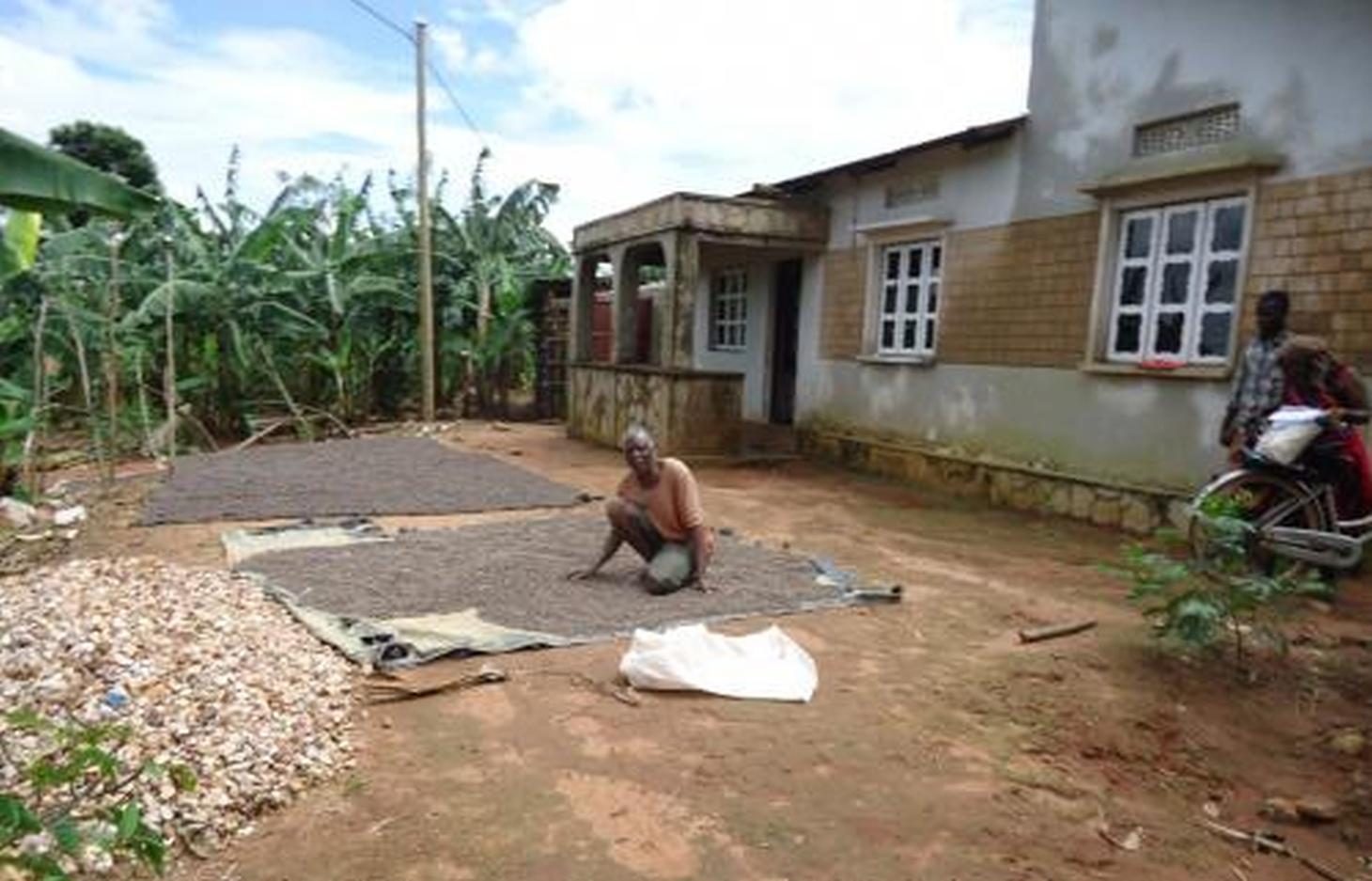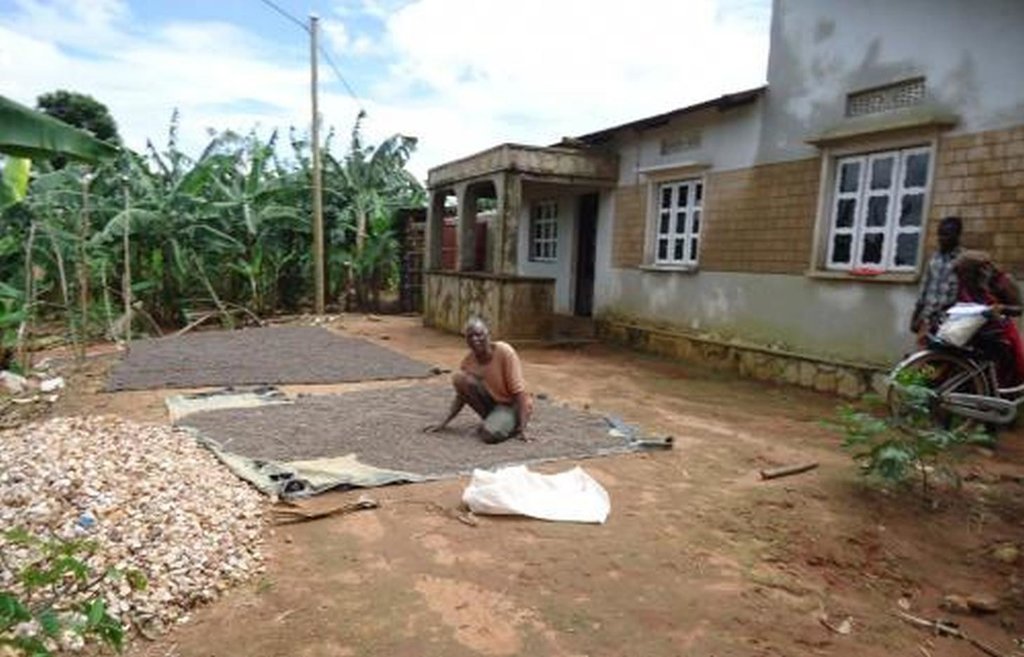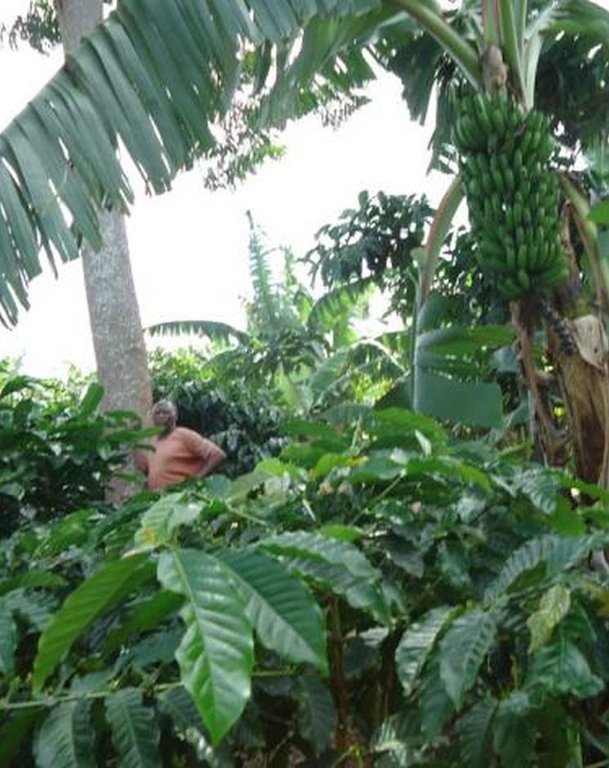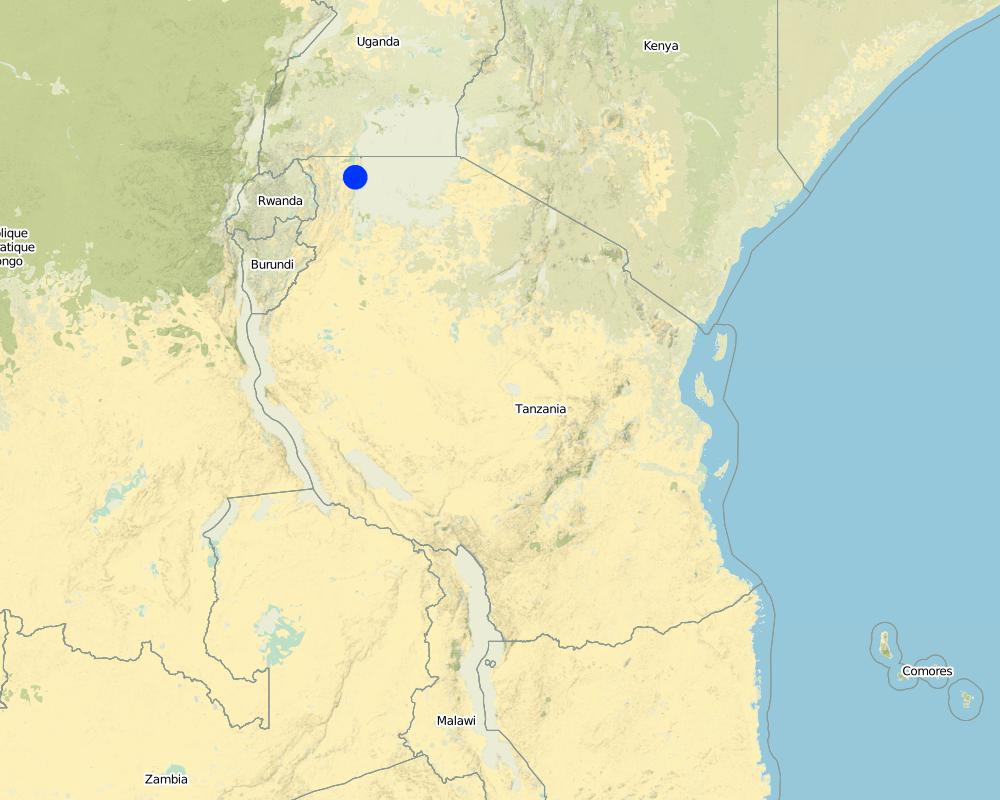Buhaya agroforestry system [ប្រទេសតង់សានី]
- ការបង្កើត៖
- បច្ចុប្បន្នភាព
- អ្នកចងក្រង៖ Godfrey Baraba
- អ្នកកែសម្រួល៖ –
- អ្នកត្រួតពិនិត្យច្រើនទៀត៖ David Streiff, Alexandra Gavilano
Ekibanja (Kihaya)
technologies_1177 - ប្រទេសតង់សានី
ពិនិត្យមើលគ្រប់ផ្នែក
ពង្រីកមើលទាំងអស់ បង្រួមទាំងអស់1. ព័ត៌មានទូទៅ
1.2 ព័ត៌មានលម្អិតពីបុគ្គលសំខាន់ៗ និងស្ថាប័នដែលចូលរួមក្នុងការវាយតម្លៃ និងចងក្រងឯកសារនៃបច្ចេកទេស
អ្នកជំនាញឯកទេស SLM:
Government :
Government :
Mashauri Babylus
Bukoba DC
ប្រទេសតង់សានី
Government :
Rutatatinisibwa Dominick
Bukoba DC
ប្រទេសតង់សានី
Government :
Rwezaula Raphael
Bukoba DC
ប្រទេសតង់សានី
អ្នកជំនាញឯកទេស SLM:
Kaihura Fidelis
K-TAMP
ប្រទេសតង់សានី
អ្នកប្រើប្រាស់ដី:
Shaaban Habibu
Kyema village farmer
ប្រទេសតង់សានី
ឈ្មោះគម្រោងដែលបានចងក្រងឯកសារ/ វាយតម្លៃលើបច្ចេកទេស (បើទាក់ទង)
The Transboundary Agro-ecosystem Management Project for the Kagera River Basin (GEF-FAO / Kagera TAMP )ឈ្មោះអង្គភាពមួយ (ច្រើន) ដែលបានចងក្រងឯកសារ/ វាយតម្លៃបច្ចេកទេស (បើទាក់ទង)
FAO Food and Agriculture Organization (FAO Food and Agriculture Organization) - ប្រទេសអ៊ីតាលីឈ្មោះអង្គភាពមួយ (ច្រើន) ដែលបានចងក្រងឯកសារ/ វាយតម្លៃបច្ចេកទេស (បើទាក់ទង)
Bukoba district council (Bukoba district council) - ប្រទេសតង់សានី1.3 លក្ខខណ្ឌទាក់ទងទៅនឹងការប្រើប្រាស់ទិន្នន័យដែលបានចងក្រងតាមរយៈ វ៉ូខេត
អ្នកចងក្រង និង(បុគ្គលសំខាន់ៗ)យល់ព្រមទទួលយកនូវលក្ខខណ្ឌនានាទាក់ទងទៅនឹងការប្រើប្រាស់ទិន្នន័យដែលបានចងក្រងតាមរយៈវ៉ូខេត:
បាទ/ចា៎
1.5 ការយោងទៅលើកម្រងបញ្ជីសំណួរ (មួយ ឬច្រើន) នៃវិធីសាស្ត្រផ្សព្វផ្សាយ SLM (ដែលបានចងក្រងដោយទស្សនៈពិភពលោកស្តីពីវិធីសាស្ត្រ និងបច្ចេកទេសងអភិរក្ស WOCAT)
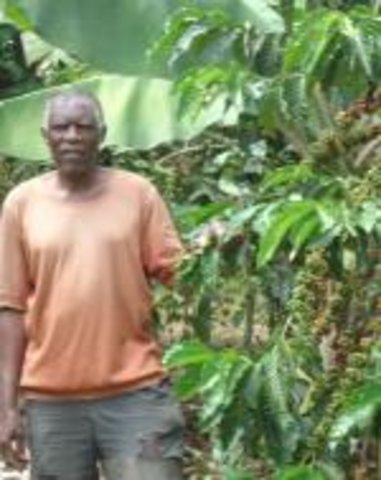
Indigenous knowledge transfer [ប្រទេសតង់សានី]
Indigenous knowledge transfer, is a common phenomena in farming societies whereby elders taught younger generations the practical aspects in production and emphasizes the norms and proms in folk story tales.
- អ្នកចងក្រង៖ Godfrey Baraba
2. ការពណ៌នាពីបច្ចេកទេស SLM
2.1 ការពណ៌នាដោយសង្ខេបពីបច្ចេកទេស
និយមន័យបច្ចេកទេស:
Traditional agroforestry system comprising mixture of banana, coffee, fruit trees, biannual crops, annual crops and timber trees which together optimize the use of soil, moisture and space.
2.2 ការពណ៌នាលម្អិតពីបច្ចេកទេស
ការពណ៌នា:
Buhaya agro forest system is a mix of annual and perennial crops together with trees and shrubs are densely planted on a restricted area usually 0.5 -2ha per household to increase crop yield, wood production and conserve soil and water. Buhaya agro forest system is applied on individual owned land specific at home steady. In this technology a plot of 1ha comprises of :
1.Perennial crops (coffee, banana, ) on average (10,000/36 coffee plants can be planted in one hector randomly in the alternating manner with banana, 10,000/25 banana stools) can be planted in 1ha randomly in the alternating manner with coffee.
2.Annual and biannual crops (eg. Maize, beans, cassava, sweet potatoes, yams etc) are planted in the between spaces. Maize and beans are planted twice in the short (Masika) and long rains (Vuli) where tubers are planted at any time throughout the year.
3.Trees and shrubs (eg. Makkhamia spps, Maesopsis and migorora). Trees are planted along the boundaries spaced at an average of 15m to act as wind break and timber production. Shrubs are planted at closed distance in between trees to act as live fence.
Buhaya agro forest system was practiced since early 1900. Application of farmyard manures and crop residue mulch are the supportive measures. The land owners keep small livestock/ few cattle under zero grazing to obtain manure for soil fertility improvem
Purpose of the Technology: The purposes for applying the technology is to control soil erosion and nutrient improvement.
Establishment / maintenance activities and inputs: The establishment of Buhaya agro forest system is done on a virgin land starting in the dry season July to September and it normally takes 2-5years by doing the following activities.
1.To prepare the land by cutting, removing/burning shrubs and grasses followed by land tillage. This is the difficult job and sometimes it can force the farmer to plant annual crops before planting perennial crops due to inadequate preparation time.
2.To dig holes of different size according to what crop is meant for in the alternating manner. This activity is done after harvesting annual crops in shot rainfalls (March to June).
3.To plant banana in July and August followed by coffee in September to November and March to May next year.
4.To plant trees along the boundaries followed by planting shrubs between the trees spacing to create a live fence.
5.To plant cassava, yams, pawpaw, avocados and mangoes. These are planted randomly and in a few quantity.
The maintenance of Buhaya agro forest system is the simple but tidies job requires all the year to be working in the garden. The required activities are
1.To weed the field as preparation for planting seasonal crops( i.e maize and beans) twice per year in dry seasons.
2.To remove unwanted banana suckers (desuckering) and harvested banana stems in order to maintain a required number of plants( mother, daughter and grand daughter) per stool. This requires a lot of time for assessing the plant health as well as spacing.
3.To plant and harvest maize and beans twice per year.
4.To prune coffee trees, harvest coffee cherry, dry, and market them once per year.
5.To replace harvested cassava and yams as required.
2.3 រូបភាពនៃបច្ចេកទេស
2.5 ប្រទេស/តំបន់/ទីតាំងកន្លែង ដែលបច្ចេកទេសត្រូវបានអនុវត្ត និងបានគ្រប់ដណ្តប់ដោយការវាយតម្លៃនេះ
ប្រទេស:
ប្រទេសតង់សានី
តំបន់/រដ្ឋ/ខេត្ត:
Tanzania
បញ្ជាក់បន្ថែមពីលក្ខណៈនៃទីតាំង:
Bukoba District (Kyema village)
បញ្ជាក់ពីការសាយភាយនៃបច្ចេកទេស:
- ត្រូវបានផ្សព្វផ្សាយត្រឹមតំបន់មួយ
ប្រសិនបើមិនច្បាស់ពីទំហំផ្ទៃដី សូមធ្វើការប៉ាន់ប្រម៉ាណ:
- 1-10 គម2
Map
×2.6 កាលបរិច្ឆេទនៃការអនុវត្ត
ប្រសិនបើមិនច្បាស់ឆ្នាំ សូមបញ្ជាក់កាលបរិច្ឆេទដែលប្រហាក់ប្រហែល:
- ច្រើនជាង 50 ឆ្នាំមុន (ប្រពៃណី)
2.7 ការណែនាំពីបច្ចេកទេស
សូមបញ្ជាក់តើបច្ចេកទេសត្រូវបានណែនាំឱ្យអនុវត្តដោយរបៀបណា:
- ជាផ្នែកនៃប្រព័ន្ធប្រពៃណី (> 50 ឆ្នាំ)
មតិយោបល់ (ប្រភេទនៃគម្រោង ។ល។):
It is said that in 1939 after second world war there was a hunger in Bukoba which forced people to plant banana instead of the traditional cropping of sorghum and millet. During the British colonial people were forced to cultivate coffee; as well health services introduced by Christian missionaries increased the population growth which revealed pressure on land and forced to opt agro forest.
3. ចំណាត់ថ្នាក់នៃបច្ចេកទេស SLM
3.1 គោលបំណងចម្បង (១ ឬច្រើន) នៃបច្ចេកទេសនេះ
- ការពារតំបន់ទីជម្រាល/តំបន់ខ្សែទឹកខាងក្រោមបញ្ចូលជាមួយបច្ចេកទេសផ្សេងទៀត
3.2 ប្រភេទដីប្រើប្រាស់មួយប្រភេទ (ច្រើនប្រភេទ) ដែលបានអនុវត្តបច្ចេកទេស
ដីប្រើប្រាស់ចម្រុះនៅលើដីតែមួយ:
បាទ/ចា៎
បញ្ជាក់ពីប្រភេទដីច្រើនប្រភេទ (ដីដាំដំណាំ/ដីចិញ្ចឹមសត្វ/ដីព្រៃឈើ):
- កសិរុក្ខកម្ម

ដីដាំដំណាំ
- ដំណាំប្រចាំឆ្នាំ
- ដំណាំរយៈពេលវែង (មិនមែនឈើ)
- ប្រភេទដើមឈើធំៗ និងដើមឈើតូចៗ
ដំណាំប្រចាំឆ្នាំ - បញ្ជាក់ប្រភេទដំណាំ:
- ធញ្ញជាតិ - ពោត
- ពពួកសណ្តែក - សណ្តែកបារាំង
- ឬស/ដំណាំមើម - ដំឡូងជ្វា ពពួកដំឡូង ត្រាវ ផ្សេងៗ
ដំណាំរយៈពេលវែង (មិនមែនឈើ) - បញ្ជាក់ប្រភេទដំណាំ:
- ចេក/plantain/abaca
ប្រភេទដើមឈើធំៗ និងដើមឈើតូចៗ - បញ្ជាក់ប្រភេទ:
- កាហ្វេ នៅតូចមិនទាន់មានម្លប់
- ផ្លែឈើផ្សេងៗ
- Makkhamia spps, Maesopsis and Migorora
ចំនួនសារដែលដាំដំណាំក្នុងមួយឆ្នាំ:
- 2
សូមបញ្ជាក់:
Longest growing period in days: 120; Longest growing period from month to month: September to December; Second longest growing period in days: 65; Second longest growing period from month to month: March to May

ដីសម្រាប់ចិញ្ចឹមសត្វ
ប្រភេទសត្វ:
- សត្វពាហនៈ - សត្វចិញ្ចឹមមិនយកទឹកដោះតែសម្រាប់យកកម្លាំងពលកម្ម
មតិយោបល់:
Major land use problems (compiler’s opinion): The major land use problem was soil erosion and excessive nutrient mining
Major land use problems (land users’ perception): Limited suitable land for cropping in the area
Future (final) land use (after implementation of SLM Technology): Mixed: Mf: Agroforestry
3.4 ការផ្គត់ផ្គង់ទឹក
ការផ្គត់ផ្គង់ទឹកនៅកន្លែងអនុវត្តបច្ចេកទេស:
- ទឹកភ្លៀង
3.5 ក្រុម SLM ដែលបច្ចេកទេសស្ថិតនៅក្នុង
- កសិរុក្ខកម្ម
3.6 វិធានការ SLM ដែលបញ្ចូលនូវបច្ចេកទេស

វិធានការក្សេត្រសាស្ត្រ
- A1: ដំណាំ/គម្របដី

វិធានការរុក្ខជាតិ
- V1: ឈើធំៗ និងដើមឈើតូចៗ
- V2: ស្មៅនិងរុក្ខជាតិៗដែលដុះមានអាយុមិនលើសពី 2ឆ្នាំ

វិធានការគ្រប់គ្រង
- M1: ការផ្លាស់ប្តូរប្រភេទដីប្រើប្រាស់
មតិយោបល់:
Secondary measures: agronomic measures
Type of vegetative measures: scattered / dispersed
3.7 កំណត់ប្រភេទនៃការធ្លាក់ចុះគុណភាពដីសំខាន់ៗដែលបច្ចេកទេសនេះបានដោះស្រាយ

ការហូរច្រោះដីដោយសារទឹក
- Wt: ការបាត់ដីស្រទាប់លើដោយការហូរច្រោះ

ការធ្លាក់ចុះសារធាតុគីមីក្នុងដី
- Cn: ការថយចុះជីជាតិ និងកាត់បន្ថយបរិមាណសារធាតុសរីរាង្គ (មិនកើតឡើងដោយការហូរច្រោះទេ)
មតិយោបល់:
Main causes of degradation: soil management (cultivation along the slopes versus across the slopes.), crop management (annual, perennial, tree/shrub) (Routeenly harvests without fertilization implies permanent removal of nutriets.), Heavy / extreme rainfall (intensity/amounts) (average rainfall 1,200mm on slopes), other natural causes (avalanches, volcanic eruptions, mud flows, highly susceptible natural resources, extreme topography, etc.) specify (Sandstone parent material), education, access to knowledge and support services (Inadequate extension services)
Secondary causes of degradation: poverty / wealth (Limited household income to invest in sustainable land management), labour availability (Labour force dominated by the elderly)
3.8 ការពារ កាត់បន្ថយ ឬស្តារឡើងវិញនៃការធ្លាក់ចុះគុណភាពដី
បញ្ជាក់ពីគោលដៅរបស់បច្ចេកទេស ដែលផ្តោតទៅការធ្លាក់ចុះគុណភាពដី:
- ការការពារការធ្លាក់ចុះគុណភាពដី
- ការកាត់បន្ថយការធ្លាក់ចុះគុណភាពដី
មតិយោបល់:
Secondary goals: mitigation / reduction of land degradation
4. បច្ចេកទេសជាក់លាក់ សកម្មភាពអនុវត្ត ធាតុចូល និងថ្លៃដើម
4.1 គំនូសបច្ចេកទេសនៃបច្ចេកទេសនេះ
លក្ខណៈពិសេសនៃបច្ចេកទេស (ទាក់ទងនឺងគំនូរបច្ចេកទេស):
Overview of the Buhaya agroforestry system. Average of 5m spacing between banana plants then alternate with coffee after two stools. Cassava and yams scattered at the space after 6 to 10 stools. beans and maize are planted in the left space to make sure all soil surface is covered. Long trees (Maesopsis spps) spaced at 10m.
Location: Kyema village. Bukoba/Kagera/Tanzania
Date: 22 MAY 2012
Technical knowledge required for field staff / advisors: moderate (The importance of diversification for income stabilization.)
Technical knowledge required for land users: moderate (Trees can improve income generating and assure food security in the sense of food accessibility.)
Main technical functions: improvement of ground cover, increase in organic matter, increase in nutrient availability (supply, recycling,…)
Secondary technical functions: control of raindrop splash, control of dispersed runoff: retain / trap, stabilisation of soil (eg by tree roots against land slides), increase of infiltration, increase / maintain water stored in soil, reduction in wind speed
Scattered / dispersed
Vegetative material: T : trees / shrubs, F : fruit trees / shrubs, C : perennial crops, O : other
Trees/ shrubs species: Makhamia spp, Maesopsis eminii are planted
Fruit trees / shrubs species: Mangifera indica, Carica papaya, Persia americana are planted
Perennial crops species: Musa spp are planted
Change of land use type: Change from cropland (Annual and biannual crop production eg. millet, sorghum and beans) to Aggro forest.
ឈ្មោះអ្នកនិពន្ធ:
Godfrey Baraba, BOX 491, BUKOBA
4.2 ព័ត៌មានទូទៅដែលពាក់ព័ន្ធនឹងការគណនាធាតុចូល និងថ្លៃដើម
កំណត់រូបិយប័ណ្ណសម្រាប់ថ្លៃដើម:
- ដុល្លារ
កំណត់ថ្លៃឈ្នួលជាមធ្យមនៃការជួលកម្លាំងពលកម្មក្នុងមួយថ្ងៃ:
1.60
4.3 សកម្មភាពបង្កើត
| សកម្មភាព | រយៈពេល (រដូវកាល) | |
|---|---|---|
| 1. | Land preparation | July to August |
| 2. | Digging holes | Jan & Jul |
| 3. | Planting banana and coffee | Jul to Sep |
| 4. | Planting trees and shrubs | Feb & Sep |
| 5. | Planting biannual crops | March, Apr, Oct, Nov &Dec |
4.4 ថ្លៃដើម និងធាតុចូលដែលត្រូវការសម្រាប់ការបង្កើតបច្ចេកទេស
| បញ្ជាក់ពីធាតុចូល | ឯកតា | បរិមាណ | ថ្លៃដើមក្នុងមួយឯកតា | ថ្លៃធាតុចូលសរុប | % នៃថ្លៃដើមដែលចំណាយដោយអ្នកប្រើប្រាស់ដី | |
|---|---|---|---|---|---|---|
| កម្លាំងពលកម្ម | Land preparation | persons/day/ha | 333,3 | 1,25 | 416,63 | 100,0 |
| កម្លាំងពលកម្ម | Digging holes | persons/day/ha | 81,63 | 1,25 | 102,04 | 100,0 |
| កម្លាំងពលកម្ម | Planting banana and coffee | persons/day/ha | 33,33 | 1,25 | 41,66 | 100,0 |
| កម្លាំងពលកម្ម | Planting trees, shrubs and biannual crops | persons/day/ha | 158,6 | 1,25 | 198,25 | 100,0 |
| សម្ភារៈ | Axes | pieces/ha | 5,55 | 3,128 | 17,36 | 100,0 |
| សម្ភារៈ | Machete | pieces/ha | 5,55 | 1,877 | 10,42 | 100,0 |
| សម្ភារៈ | Hand hoes | pieces/ha | 5,55 | 3,128 | 17,36 | 100,0 |
| សម្ភារៈ | Spades | pieces/ha | 2,7 | 3,148 | 8,5 | 100,0 |
| សម្ភារៈដាំដុះ | Banana suckers | pieces/ha | 571,0 | 0,1875 | 107,06 | 100,0 |
| សម្ភារៈដាំដុះ | Coffee seedlings | pieces/ha | 357,0 | 0,3125 | 111,56 | 100,0 |
| សម្ភារៈដាំដុះ | Mysopsis | pieces/ha | 33,0 | 0,125 | 4,13 | 100,0 |
| សម្ភារៈដាំដុះ | Migorora | pieces/ha | 80,0 | 0,125 | 10,0 | 100,0 |
| សម្ភារៈដាំដុះ | Avocado | pieces/ha | 11,0 | 3,167 | 34,84 | 100,0 |
| សម្ភារៈដាំដុះ | Mangoes | pieces/ha | 5,0 | 3,125 | 15,63 | 100,0 |
| សម្ភារៈដាំដុះ | Cassava | pieces/ha | 47,0 | 0,0317 | 1,49 | 100,0 |
| សម្ភារៈដាំដុះ | Yams | pieces/ha | 26,0 | 0,031 | 0,81 | |
| ថ្លៃដើមសរុបក្នុងការបង្កើតបច្ចេកទេស | 1097,74 | |||||
| ថ្លៃដើមសរុបក្នុងការបង្កើតបច្ចេកទេសគិតជាដុល្លារ | 1097,74 | |||||
មតិយោបល់:
Duration of establishment phase: 12 month(s)
4.5 សកម្មភាពថែទាំ
| សកម្មភាព | ពេលវេលា/ ភាពញឹកញាប់ | |
|---|---|---|
| 1. | Weeding | Feb & Sep |
| 2. | Desuckering | Jul to Sept |
| 3. | Planting annual crops | March to Jul & Sep to Dec |
| 4. | Punning, harvesting and drying coffee | May to October |
| 5. | Cassava and yams harvesting. | Jan to Dec |
4.6 កំណត់ថ្លៃដើមសម្រាប់ការថែទាំ/ សកម្មភាពរបស់បច្ចេកទេស (ក្នុងរយៈពេលមួយឆ្នាំ)
| បញ្ជាក់ពីធាតុចូល | ឯកតា | បរិមាណ | ថ្លៃដើមក្នុងមួយឯកតា | ថ្លៃធាតុចូលសរុប | % នៃថ្លៃដើមដែលចំណាយដោយអ្នកប្រើប្រាស់ដី | |
|---|---|---|---|---|---|---|
| កម្លាំងពលកម្ម | Weeding | persons/day/ha | 200,0 | 1,25 | 250,0 | 100,0 |
| កម្លាំងពលកម្ម | Desuckering | persons/day/ha | 57,0 | 1,25 | 71,25 | 100,0 |
| កម្លាំងពលកម្ម | Planting annual crops | persons/day/ha | 50,0 | 1,25 | 62,5 | 100,0 |
| កម្លាំងពលកម្ម | Prunning, harvesting and drying coffee | persons/day/ha | 285,5 | 1,25 | 356,88 | 100,0 |
| សម្ភារៈដាំដុះ | Seeds | pieces/ha | 10,0 | 2,5 | 25,0 | 100,0 |
| សម្ភារៈដាំដុះ | Seedlings | pieces/ha | 26,0 | 0,031 | 0,81 | 100,0 |
| សម្ភារៈដាំដុះ | Cassava | pieces/ha | 48,0 | 0,0317 | 1,52 | 100,0 |
| សម្ភារៈដាំដុះ | Beans | pieces/ha | 20,0 | 1,25 | 25,0 | 100,0 |
| ផ្សេងៗ | Labour: Cassava and yams harvesting | persons/day/ha | 2,3 | 1,25 | 2,88 | 100,0 |
| ថ្លៃដើមសរុបសម្រាប់ការថែទាំដំណាំតាមបច្ចេកទេស | 795,84 | |||||
| ថ្លៃដើមសរុបសម្រាប់ការថែទាំដំណាំតាមបច្ចេកទេសគិតជាដុល្លារ | 795,84 | |||||
មតិយោបល់:
The above cost was calculated as 1manday equivalent to 8 working hours with the following performances; ploughing 30m2, weeding 400m2, land clearing 10m2, de suckering 30 stools, Harvesting and pruning 3 coffee trees.
4.7 កត្តាសំខាន់បំផុតដែលមានឥទ្ធិពលដល់ការចំណាយ
ពណ៌នាពីកត្តាប៉ះពាល់ចម្បងៗទៅលើថ្លៃដើម:
The most determinate factor affecting the cost is labour. This is because the technology is labour intensive, while labour force is inadequate.
5. លក្ខណៈបរិស្ថានធម្មជាតិ និងមនុស្ស
5.1 អាកាសធាតុ
បរិមាណទឹកភ្លៀងប្រចាំឆ្នាំ
- < 250 មម
- 251-500 មម
- 501-750 មម
- 751-1,000 មម
- 1,001-1,500 មម
- 1,501-2,000 មម
- 2,001-3,000 មម
- 3,001-4,000 មម
- > 4,000 មម
លក្ខណៈពិសេស/ មតិយោបល់លើរដូវភ្លៀង:
Bimodal, length of dry period 180dys
តំបន់កសិអាកាសធាតុ
- មានភ្លៀងមធ្យម
Thermal climate class: tropics
5.2 សណ្ឋានដី
ជម្រាលជាមធ្យម:
- រាបស្មើ (0-2%)
- ជម្រាលតិចតួច (3-5%)
- មធ្យម (6-10%)
- ជម្រាលខ្ពស់បន្តិច (11-15%)
- ទីទួល (16-30%)
- ទីទួលចោត (31-60%)
- ទីទួលចោតខ្លាំង (>60%)
ទម្រង់ដី:
- ខ្ពង់រាប
- កំពូលភ្នំ
- ជម្រាលភ្នំ
- ជម្រាលទួល
- ជម្រាលជើងភ្នំ
- បាតជ្រលងភ្នំ
តំបន់តាមរយៈកម្ពស់ :
- 0-100 ម
- 101-500 ម
- 501-1,000 ម
- 1,001-1,500 ម
- 1,501-2,000 ម
- 2,001-2,500 ម
- 2,501-3,000 ម
- 3,001-4,000 ម
- > 4,000 ម
បញ្ជាក់ថាតើបច្ចេកទេសនេះត្រូវបានអនុវត្តន៍នៅក្នុង:
- សណ្ឋានដីប៉ោង
មតិយោបល់ និងបញ្ចាក់បន្ថែមអំពីសណ្ឋានដី :
Slopes on average: 12.8%
Altitudinal zone: 1194m.a.s.l. taken by GPS
5.3 ដី
ជម្រៅដីជាមធ្យម:
- រាក់ខ្លាំង (0-20 សម)
- រាក់ (21-50 សម)
- មធ្យម (51-80 សម)
- ជ្រៅ (81-120 សម)
- ជ្រៅខ្លាំង (> 120 សម)
វាយនភាពដី (ស្រទាប់លើ):
- គ្រើម/ មានពន្លឺ (ខ្សាច់)
- មធ្យម (ល្បាយ, ល្បាប់)
សារធាតុសរីរាង្គនៅស្រទាប់ដីខាងលើ:
- មធ្យម (1-3%)
បើអាចសូមភ្ជាប់ការពណ៌នាពីដីឱ្យបានច្បាស់ ឬព័ត៌មានដែលអាចទទួលបាន ឧ. ប្រភេទដី, pH ដី/ ជាតិអាស៊ីត, សមត្ថភាពផ្លាស់ប្តូរកាចុង, វត្តមាននីត្រូសែន, ភាពប្រៃ ។ល។:
Soil fertility is medium - low
Soil drainage / infiltration is good - medium
Soil water storage capacity is medium
5.4 ទឹកដែលអាចទាញមកប្រើប្រាស់បាន និងគុណភាពទឹក
នីវ៉ូទឹកក្រោមដី:
5-50 ម
ទឹកលើដីដែលអាចទាញយកប្រើប្រាស់បាន:
ល្អ
គុណភាពទឹក (មិនបានធ្វើប្រត្តិកម្ម):
ទឹកពិសារដែលគ្មានគុណភាព (តម្រូវឱ្យមានការសំអាត)
មតិយោបល់ និងលក្ខណៈពិសេសផ្សេងៗទៀតលើគុណភាព និងបរិមាណទឹក :
Availability of surface water: Permanent water stream in plenty
Water quality (untreated): Tap water not found in the whole village
5.5 ជីវៈចម្រុះ
ភាពសម្បូរបែបនៃប្រភេទ:
- កម្រិតមធ្យម
មតិយោបល់ និងលក្ខណៈពិសេសផ្សេងទៀតលើជីវចម្រុះ:
Butterflies, earthworm and ants readily available
5.6 លក្ខណៈនៃអ្នកប្រើប្រាស់ដីដែលអនុវត្តបច្ចេកទេស
ទីផ្សារនៃប្រព័ន្ធផលិតកម្ម:
- ពាក់កណ្តាលពាណិជ្ជកម្ម (ផ្គត់ផ្គង់ខ្លួនឯង/ ពាណិជ្ជកម្ម)
ចំណូលក្រៅកសិកម្ម:
- តិចជាង 10% នៃចំណូល
កម្រិតជីវភាព:
- មិនល្អ
- មធ្យម
ឯកជន ឬក្រុម:
- ធ្វើខ្លួនឯង/ គ្រួសារ
កម្រិតប្រើប្រាស់គ្រឿងយន្ត:
- ប្រើកម្លាំងពលកម្ម
យេនឌ័រ:
- ស្ត្រី
- បុរស
សូមបញ្ជាក់ពីលក្ខណៈពាក់ព័ន្ធផ្សេងទៀតអំពីអ្នកប្រើប្រាស់ដី:
Land users applying the Technology are mainly common / average land users
Difference in the involvement of women and men: Men usually plays part in field establishment while women engaged in maintenance. Children participates in maintenance as well.
Population density: 200-500 persons/km2
Annual population growth: 1% - 2%
5% of the land users are rich and own 30% of the land.
75% of the land users are average wealthy and own 60% of the land.
20% of the land users are poor and own 10% of the land.
Off-farm income specification: The one who did not apply the technology depends on more than 85% of his income from off farm activities.
Market orientation of production system: Coffee is 100% for commecial the rest are for home consumption.
Level of mechanization: Land cultivation only at establishement, then weeding is done by bare hands and planting bu small hand hoes (vihosho)
5.7 ទំហំផ្ទៃដីជាមធ្យមនៃដីប្រើប្រាស់ដោយអ្នកប្រើប្រាស់ដី ក្នុងការអនុវត្តបច្ចេកទេស
- < 0.5 ហិកតា
- 0.5-1 ហិកតា
- 1-2 ហិកតា
- 2-5 ហិកតា
- 5-15 ហិកតា
- 15-50 ហិកតា
- 50-100 ហិកតា
- 100-500 ហិកតា
- 500-1,000 ហិកតា
- 1,000-10,000 ហិកតា
- > 10,000 ហិកតា
តើផ្ទៃដីនេះចាត់ទុកជាទំហំកម្រិតណាដែរ ខ្នាតតូច មធ្យម ឬខ្នាតធំ (ធៀបនឹងបរិបទតំបន់)?
- ខ្នាតតូច
មតិយោបល់:
No larger arable land found unoccupied in the areas.
5.8 ភាពជាម្ចាស់ដី កម្មសិទ្ធប្រើប្រាស់ដី និងកម្មសិទ្ធប្រើប្រាស់ទឹក
ភាពជាម្ចាស់ដី:
- ឯកជន មិនមានកម្មសិទ្ធ
កម្មសិទ្ធិប្រើប្រាស់ដី:
- ជាក្រុម (មានដែនកំណត់)
- ឯកជន
កម្មសិទ្ធប្រើប្រាស់ទឹក:
- អាស្រ័យផលសេរី (មិនមានការកំណត់)
មតិយោបល់:
Water sources are mainly permanent streams found in different land ownership, but water uses are free.
5.9 ការប្រើប្រាស់សេវាកម្ម និងហេដ្ឋារចនាសម្ព័ន្ធ
សុខភាព:
- មិនល្អ
- មធ្យម
- ល្អ
ការអប់រំ:
- មិនល្អ
- មធ្យម
- ល្អ
ជំនួយបច្ចេកទេស:
- មិនល្អ
- មធ្យម
- ល្អ
ការងារ (ឧ. ការងារក្រៅកសិដ្ឋាន):
- មិនល្អ
- មធ្យម
- ល្អ
ទីផ្សារ:
- មិនល្អ
- មធ្យម
- ល្អ
ថាមពល:
- មិនល្អ
- មធ្យម
- ល្អ
ផ្លូវ និងការដឹកជញ្ជូន:
- មិនល្អ
- មធ្យម
- ល្អ
ទឹកផឹក និងអនាម័យ:
- មិនល្អ
- មធ្យម
- ល្អ
សេវាកម្មហិរញ្ញវត្ថុ:
- មិនល្អ
- មធ្យម
- ល្អ
6. ផលប៉ះពាល់ និងការសន្និដ្ឋាន
6.1 ផលប៉ះពាល់ក្នុងបរិវេណអនុវត្តបច្ចេកទេសដែលកើតមាន
ផលប៉ះពាល់លើសេដ្ឋកិច្ចសង្គម
ផលិតផល
ផលិតកម្មដំណាំ
គុណភាពមុន SLM:
16kg
គុណភាពក្រោយ SLM:
35kg
ផលិតកម្មឈើ
ការគ្រប់គ្រងដី
មតិយោបល់/ ការបញ្ជាក់:
All crops are weeded at once
ចំណូល និងថ្លៃដើម
ចំណូលក្នុងកសិដ្ឋាន
ភាពសម្បូរបែបប្រភពប្រាក់ចំណូល
បន្ទុកការងារ
ផលប៉ះពាល់ទៅលើវប្បធម៌សង្គម
សន្តិសុខស្បៀង/ ភាពគ្រប់គ្រាន់ខ្លួនឯង
មតិយោបល់/ ការបញ្ជាក់:
Individual had excess food for sale
ស្ថានភាពសុខភាព
ឱកាសវប្បធម៍
មតិយោបល់/ ការបញ្ជាក់:
Individual exposuers to expatriet and trading partners
ចំណេះដឹង SLM / ការធ្លាក់ចុះគុណភាពដី
មតិយោបល់/ ការបញ្ជាក់:
No wind break events reported in the area
ស្ថានភាពក្រុមដែលមានបញ្ហាក្នុងសង្គម និងសេដ្ឋកិច្ច
livelihood and human well-being
មតិយោបល់/ ការបញ្ជាក់:
This technology supports high quality and quantity coffee and other crops production and as a results improves farmers income.
ផលប៉ះពាល់ទៅលើអេកូឡូស៊ី
វដ្តទឹក/លំហូរ
លំហូរទឹកលើផ្ទៃដី
រំហួត
ដី
សំណើមដី
គម្របដី
វដ្តនៃសារធាតុចិញ្ចឹម/ការទទួលបាន
ជីវចម្រុះ៖ ដំណាំ, សត្វ
ជីវម៉ាស/ កាបូនលើដី
ភាពសម្បូរបែបនៃរុក្ខជាតិ
ការគ្រប់គ្រងកត្តាចង្រៃ/ ជំងឺ
ការកាត់បន្ថយហានិភ័យនៃគ្រោះមហន្តរាយ និងគ្រោះអាកាសធាតុ
ល្បឿនខ្យល់
6.2 ផលប៉ះពាល់ក្រៅបរិវេណអនុវត្តបច្ចេកទេសដែលកើតមាន
ខ្យល់នាំយកនូវធូរលី
ខូចខាតដល់ស្រែអ្នកជិតខាង
ខូចខាតដល់ហេដ្ឋារចនាសម្ព័ន្ធសាធារណៈ/ឯកជន
6.3 ភាពប្រឈម និងភាពរួសនៃបច្ចេកទេសទៅនឹងការប្រែប្រួលអាកាសធាតុ និងគ្រោះអាកាសធាតុ/ គ្រោះមហន្តរាយ (ដែលដឹងដោយអ្នកប្រើប្រាស់ដី)
ការប្រែប្រួលអាកាសធាតុ
ការប្រែប្រួលអាកាសធាតុ
| រដូវកាល | កើនឡើង ឬថយចុះ | លក្ខណៈឆ្លើយតបនៃបច្ចេកទេសទៅនឹងការប្រែប្រួលអាកាសធាតុ | |
|---|---|---|---|
| សីតុណ្ហភាពប្រចាំឆ្នាំ | កើនឡើង | ល្អ |
គ្រោះអាកាសធាតុ (មហន្តរាយ)
គ្រោះមហន្តរាយធម្មជាតិ
| លក្ខណៈឆ្លើយតបនៃបច្ចេកទេសទៅនឹងការប្រែប្រួលអាកាសធាតុ | |
|---|---|
| ព្យុះភ្លៀងតាមតំបន់ | មិនល្អ |
| ព្យុះកំបុតត្បូងតាមតំបន់ | ល្អ |
គ្រោះមហន្តរាយអាកាសធាតុ
| លក្ខណៈឆ្លើយតបនៃបច្ចេកទេសទៅនឹងការប្រែប្រួលអាកាសធាតុ | |
|---|---|
| រាំងស្ងួត | ល្អ |
គ្រោះមហន្តរាយទឹក
| លក្ខណៈឆ្លើយតបនៃបច្ចេកទេសទៅនឹងការប្រែប្រួលអាកាសធាតុ | |
|---|---|
| ទឹកជំនន់ទូទៅ (ទន្លេ) | មិនល្អ |
ផលវិបាកដែលទាក់ទងនឹងបរិយាកាសផ្សេងៗទៀត
ផលវិបាកដែលទាក់ទងនឹងបរិយាកាសផ្សេងៗទៀត
| លក្ខណៈឆ្លើយតបនៃបច្ចេកទេសទៅនឹងការប្រែប្រួលអាកាសធាតុ | |
|---|---|
| កាត់បន្ថយពេលដាំដុះ | ល្អ |
មតិយោបល់:
use of new adapted varieties.
6.4 ការវិភាគថ្លៃដើម និងអត្ថប្រយោជន៍
តើផលចំណេញ និងថ្លៃដើមត្រូវបានប្រៀបធៀបគ្នាយ៉ាងដូចម្តេច (ទស្សនៈរបស់អ្នកប្រើប្រាស់ដី)?
រយៈពេលខ្លី:
វិជ្ជមានតិចតួច
រយៈពេលវែង:
វិជ្ជមាន
តើផលចំណេញ និងការថែទាំ/ ជួសជុលត្រូវបានប្រៀបធៀបគ្នាយ៉ាងដូចម្តេច (ទស្សនៈរបស់អ្នកប្រើប្រាស់ដី)?
រយៈពេលខ្លី:
វិជ្ជមានតិចតួច
រយៈពេលវែង:
វិជ្ជមាន
6.5 ការទទួលយកបច្ចេកទេស
- > 50%
បើអាច សូមបញ្ជាក់ពីបរិមាណ (ចំនួនគ្រួសារ និង/ ឬតំបន់គ្របដណ្តប់):
387 households covering 75 percent of the stated area
ក្នុងចំណោមគ្រួសារទាំងអស់ដែលបានអនុវត្តបច្ចេកទេស តើមានប៉ុន្មានគ្រួសារដែលចង់ធ្វើដោយខ្លួនឯង ដោយមិនទទួលបានសម្ភារៈលើកទឹកចិត្ត/ប្រាក់ឧបត្ថម្ភ?:
- 91-100%
មតិយោបល់:
387 land user families have adopted the Technology without any external material support
Comments on spontaneous adoption: Almost 75% of the area is under agroforestry practices.
There is a strong trend towards spontaneous adoption of the Technology
Comments on adoption trend: The technique has been in place for centuries
The average farm size is 1 acre per households and all 607 households implemented this technology. Other technologies are practiced in different area within the village. Therefore the SLM technology area is approximately 15% of the total catchment area.
6.7 ភាពខ្លាំង/ គុណសម្បត្តិ/ ឱកាសនៃបច្ចេកទេស
| ភាពខ្លាំង/ គុណសម្បត្តិ/ ឱកាសនៅកន្លែងរបស់អ្នកប្រើប្រាស់ដី |
|---|
|
Diversification of production How can they be sustained / enhanced? Improved farmers knowledge and skills in agroforestry systems management |
|
Reliable income from multiple crops. How can they be sustained / enhanced? Knowledge in farming as a business |
|
Technology is traditional and widely accepted How can they be sustained / enhanced? Strengthen linkages to sources of improved technologies |
|
Reduced workload How can they be sustained / enhanced? Ditto |
|
Complimentarity of produced diverse crops How can they be sustained / enhanced? Ditto |
| ភាពខ្លាំង/ គុណសម្បត្តិ/ ឱកាស ទស្សនៈរបស់បុគ្គលសំខាន់ៗ |
|---|
|
The technology is not complicated in terms of input requirements and application How can they be sustained / enhanced? Improved farmer linkage to sources of improved materials e.g. research |
|
Inputs are locally and readily available How can they be sustained / enhanced? Facilitation of farmer own produced improved inputs |
|
Maintenance costs decreases with increasing production period How can they be sustained / enhanced? Ditto |
|
Markets are readily available How can they be sustained / enhanced? Feeder road maintenance should be given higher priority |
6.8 ភាពខ្សោយ/ គុណវិបត្តិ/ ហានិភ័យនៃបច្ចេកទេស និងវិធីសាស្ត្រដោះស្រាយ
| ភាពខ្សោយ/ គុណវិបត្តិ/ ហានិភ័យ ទស្សនៈរបស់អ្នកប្រើប្រាស់ដី | តើបច្ចេកទេសទាំងនោះបានដោះស្រាយបញ្ហាដូចម្តេច? |
|---|---|
| High competition of nutrients among different species | Improved farmers knowledge and skills in agroforestry systems management |
| ភាពខ្សោយ/ គុណវិបត្តិ/ ហានិភ័យ ទស្សនៈរបស់អ្នកចងក្រងឬបុគ្គលសំខាន់ៗ | តើបច្ចេកទេសទាំងនោះបានដោះស្រាយបញ្ហាដូចម្តេច? |
|---|---|
| Some tree species host pests | Improve farmers knowledge on tree pests prevention and cleaning |
| Limits farm mechanization | Improved farmers knowledge and skills on improved maintenance without mechanization |
7. ឯកសារយោង និងវេបសាយ
7.1 វិធីសាស្ត្រ/ ប្រភពនៃព័ត៌មាន
7.2 ឯកសារយោងដែលបានចេញផ្សាយ
ចំណងជើង អ្នកនិពន្ធ ឆ្នាំ ISBN:
Kagera TAMP project website
មានប្រភពមកពីណា? ថ្លៃដើមប៉ុន្មាន?
http://www.fao.org/nr/kagera/partners-contacts/tanzania/en/
ការតភ្ជាប់ និងម៉ូឌុល
ពង្រីកមើលទាំងអស់ បង្រួមទាំងអស់ការតភ្ជាប់

Indigenous knowledge transfer [ប្រទេសតង់សានី]
Indigenous knowledge transfer, is a common phenomena in farming societies whereby elders taught younger generations the practical aspects in production and emphasizes the norms and proms in folk story tales.
- អ្នកចងក្រង៖ Godfrey Baraba
ម៉ូឌុល
គ្មានម៉ូឌុល


